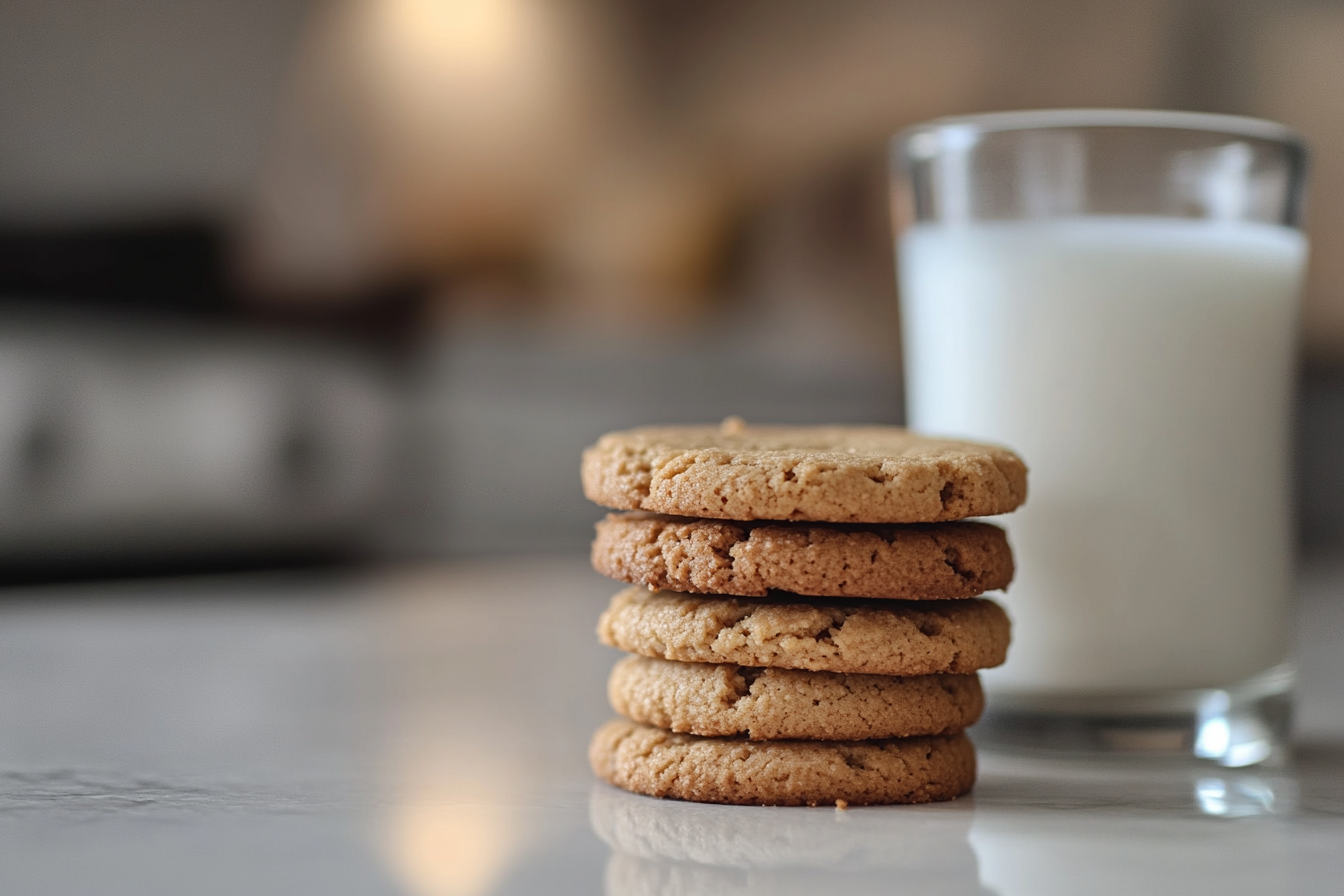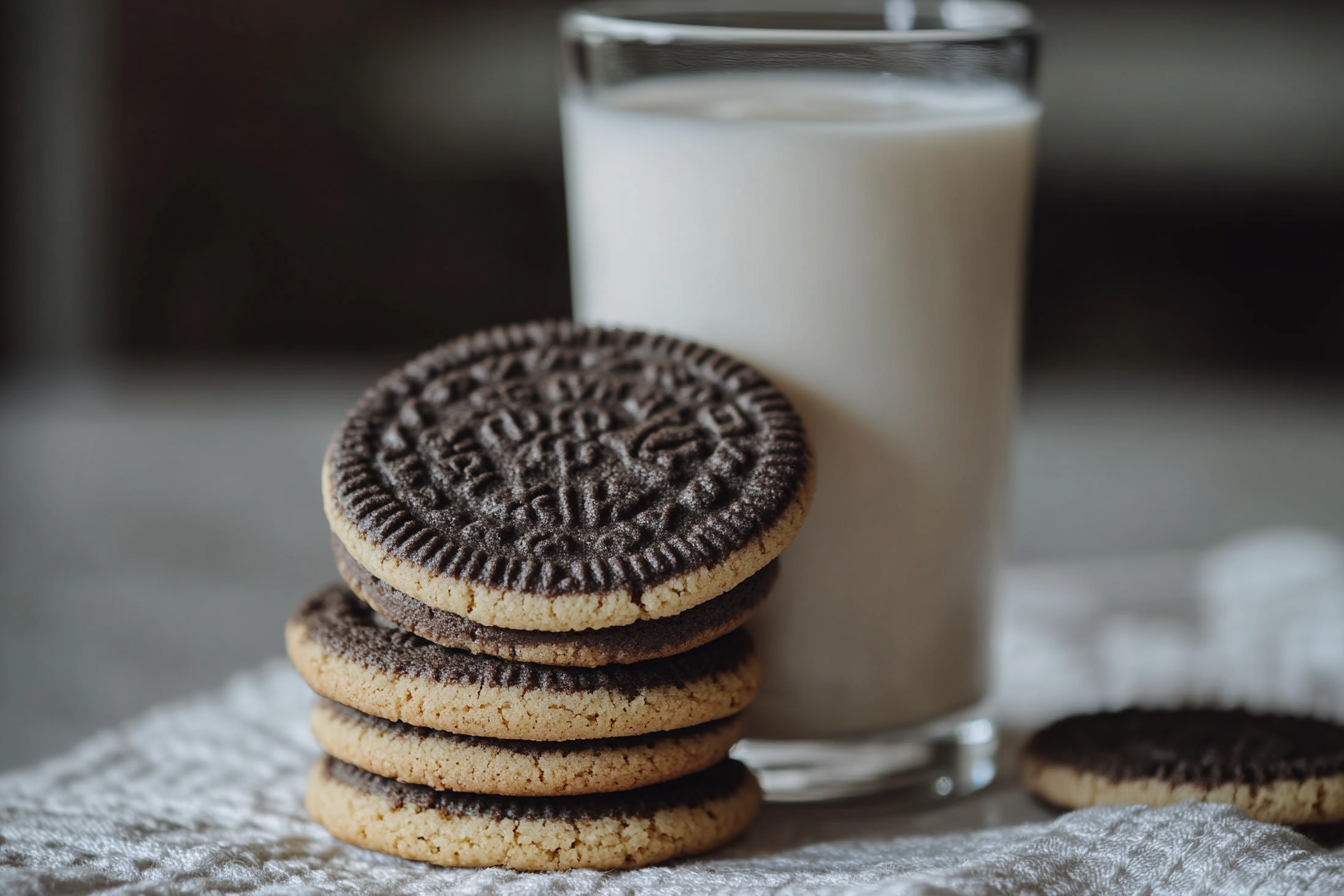There are few food pairings as iconic as milk and cookies. Whether you’re enjoying a warm, freshly baked cookie or dunking a crispy one into a cold glass of milk, this combination is one of life’s simple pleasures. But what exactly happens when you dunk a cookie into milk? Why do these two foods complement each other so perfectly?
This article explores the science, history, and sensory experience behind the perfect pairing of milk and cookies. From the chemical reactions that take place when a cookie absorbs milk, to the traditions surrounding this beloved snack, by the end, you’ll have a deeper understanding of why these two are such a magical match.
The Science Behind Milk and Cookies
When you dunk a cookie into milk, fascinating reactions occur. These reactions don’t just change the texture—they enhance the flavor. Emulsifiers are key players here, blending fats and liquids for a smoother experience. To learn more about how ingredients affect taste, check out our detailed guide on how different ingredients affect baking.
What Are Emulsifiers?
Emulsifiers are molecules found in both milk and cookies. In milk, emulsifiers help fat molecules remain suspended in the liquid, giving it a smooth and creamy texture. In cookies, emulsifiers allow fats, oils, and water to blend into a uniform dough during the baking process. When you dunk a cookie into milk, the emulsifiers in both foods interact, working together to break down fats and sugars in the cookie, making the overall texture creamier and the flavor more balanced.
- Binding Fats and Liquids: The emulsifiers in milk act as a bridge between the fats and liquids in cookies, allowing them to blend smoothly. This results in a creamy, luxurious mouthfeel that enhances the overall experience.
- Reducing Sweetness: The fats in milk also help to tone down the intense sweetness of cookies, making them more enjoyable and less overwhelming.
How Emulsifiers Affect Taste
Emulsifiers are critical in balancing the flavor of milk and cookies. When you take a bite of a cookie soaked in milk, the emulsifiers in both foods work to distribute fats evenly across your palate. This ensures that the cookie doesn’t taste too greasy or overly sweet.
In particular, chocolate chip cookies benefit from this interaction. Without milk, the fats and sugars in the cookie can overpower the more subtle flavors of chocolate and butter. When paired with milk, however, these flavors become smoother and more harmonious.
- Fat-Soluble Flavors: Many of the most intense flavors in cookies—such as chocolate, vanilla, and butter—are fat-soluble. This means that they dissolve more readily in the fat content of milk, allowing you to fully appreciate these flavors when dunking your cookie.
- Sweetness Control: Milk helps moderate the sweetness of cookies, which can often be too sugary on their own. This makes the experience of eating cookies more balanced and satisfying.
For more details on how milk plays a role in enhancing flavors, check out this guide on milk and cookies.
The Sensory Experience: How Milk Transforms Cookies
Dunking a cookie into milk is not just about softening it. The process engages all your senses, transforming the way you experience both the cookie and the milk. From the moment the cookie hits the milk, the texture begins to change, and the flavor becomes smoother and more balanced.
Flavor Enhancement
When you dunk a cookie into milk, the flavors come together in a way that is rich and harmonious. The fats in the milk interact with the fats and sugars in the cookie, toning down the sweetness and enhancing the more complex flavors of chocolate, butter, and spices.
- Fat-Soluble Flavors: Flavors like vanilla, butter, and chocolate are fat-soluble, which means they dissolve more easily in the fat content of milk. As a result, dunking a cookie in milk allows these flavors to spread evenly across your palate, creating a smoother and more balanced flavor profile.
- Sweetness Control: If you find cookies too sweet on their own, milk can help reduce their sugary intensity. This is particularly important for chocolate chip cookies, which can be overly sweet without the creamy buffer of milk.
Texture and Mouthfeel
The texture of a cookie changes dramatically when it is soaked in milk. The outer layer of the cookie becomes soft, while the core remains firm, creating a pleasing contrast between the crunchy interior and the softened exterior. This transformation makes the cookie more enjoyable to eat, as it melts in your mouth and releases its flavors more readily.
- Absorption: As the cookie absorbs milk, it becomes moist and tender. The degree of softness depends on how long the cookie is dunked and the type of cookie. For instance, a short dunk will leave the cookie crisp in the center, while a longer soak will create a melt-in-your-mouth texture.
- Melt-in-Your-Mouth Effect: The fats in the cookie, particularly from ingredients like butter and chocolate, melt more easily in your mouth when combined with milk. This creates a rich, creamy sensation that makes the eating experience even more luxurious.
If you’re looking for more ideas on how to create sensory food pairings, check out our fruit platter tips, which offers other delicious combinations.
The History and Cultural Significance of Milk and Cookies
The tradition of pairing milk and cookies is deeply rooted in history and culture. While many of us associate this combination with childhood memories or holiday traditions, its origins can be traced back to ancient times.
Ancient Dunking Traditions
The act of dunking baked goods in liquid has been a common practice for centuries. In ancient Rome, people would soften their hard, dry bread by dipping it into wine. This made the bread easier to eat and allowed it to absorb some of the flavors from the wine. Over time, this tradition evolved, and cookies became the preferred baked good to pair with beverages.
- Roman Origins: Dunking hard bread or biscuits in wine was a practical solution to soften stale or tough bread, making it more palatable. This early practice paved the way for modern dunking traditions.
- Medieval Dunking: In medieval Europe, dunking bread or biscuits into liquid was a common practice, particularly among sailors. The hardtack biscuits they relied on during long voyages were notoriously dry, so they would soften them by dunking them in water, beer, or coffee.
The tradition of dunking cookies in milk became popular in the 20th century, particularly in North America, where it remains a beloved snack ritual.
Milk and Cookies in Popular Culture
The pairing of milk and cookies has become an enduring symbol of comfort, warmth, and nostalgia. Whether it’s the after-school snack that children look forward to or the classic tradition of leaving milk and cookies for Santa Claus on Christmas Eve, this combination evokes a sense of joy and togetherness.
- Santa’s Snack: The tradition of leaving milk and cookies for Santa Claus is believed to have started during the Great Depression. Parents encouraged their children to leave out a treat for Santa as a way of teaching gratitude for the gifts they received. Today, this tradition continues to be a cherished part of holiday celebrations.
- A Symbol of Nostalgia: Milk and cookies have become a symbol of childhood memories and family bonding. Whether it’s a holiday tradition or a simple after-school snack, this combination represents warmth and comfort.
Best Cookies for Dunking in Milk: A Guide
Not all cookies are created equally when it comes to dunking in milk. Some hold up better, while others fall apart. If you’re interested in more snack pairings, check out our list of must-try dessert ideas. Here’s a guide to the best cookies for dunking:
Chocolate Chip Cookies
Perhaps the most iconic cookie for dunking, chocolate chip cookies are a classic choice. The combination of buttery dough, sweet chocolate chips, and a slightly crisp exterior makes these cookies ideal for pairing with milk. The fat in the cookie blends perfectly with the milk, creating a rich and balanced flavor.
- Dunking Tip: Dip your chocolate chip cookie for just a second or two—any longer, and it may fall apart. This allows the cookie to absorb enough milk to soften without becoming too soggy.
Oatmeal Raisin Cookies
Oatmeal raisin cookies are another great option for dunking in milk. The oats absorb the milk, making the cookie chewy and flavorful. The raisins add a burst of sweetness, which is balanced by the creaminess of the milk.
- Healthier Option: Oats are high in fiber, making oatmeal raisin cookies a slightly healthier choice compared to other types of cookies. They also hold up well in milk, creating a satisfying texture.
Shortbread Cookies
Rich and buttery, shortbread cookies are another excellent choice for dunking. Their dense, crumbly texture softens just enough in milk to create a melt-in-your-mouth experience. The simplicity of shortbread allows the flavor of the milk to shine, making it a favorite for many.
- Pairing Tip: The simplicity of shortbread enhances the flavor of milk, making it a perfect match for those who enjoy a more subtle sweetness.
If you’re looking for other delicious snack ideas, check out our best birthday cake recipes.
Non-Dairy Milk Options for Cookies
While traditional cow’s milk is the classic choice for dunking cookies, non-dairy alternatives have become increasingly popular. Whether you’re lactose intolerant, vegan, or simply prefer plant-based options, there are plenty of non-dairy milks that pair beautifully with cookies. Here are some of the best non-dairy milk options for dunking:
Almond Milk
Almond milk is one of the most popular plant-based alternatives to cow’s milk. Its light, nutty flavor pairs well with a wide range of cookies, especially those with chocolate or nuts. While almond milk doesn’t have as much fat as cow’s milk, it still provides enough creaminess to complement the richness of cookies.
- Pairing Tip: Almond milk works particularly well with chocolate chip cookies and shortbread cookies.
Oat Milk
Oat milk has a creamy texture and mild, sweet flavor that makes it a great option for dunking cookies. Its natural sweetness complements the flavors of oatmeal raisin cookies or spiced cookies, like gingerbread. The creaminess of oat milk mimics that of cow’s milk, making it a satisfying alternative.
- Best for Oatmeal Cookies: Oat milk pairs exceptionally well with oatmeal cookies, enhancing their chewy texture and subtle flavors.
Soy Milk
Soy milk is another versatile option for dunking cookies. Its neutral flavor allows the cookie to take center stage, and its higher protein content gives it a rich, creamy texture similar to cow’s milk. This makes soy milk a great choice for heavier, more indulgent cookies like chocolate chip or peanut butter cookies.
FAQs About Milk and Cookies
Why Do Cookies Taste Better with Milk?
Milk contains emulsifiers that help break down the fats in cookies, creating a smoother, more balanced flavor. This interaction reduces the sweetness of the cookie while enhancing its more subtle flavors, making it more enjoyable to eat.
What Makes Milk and Cookies a Classic Pairing?
The creamy texture of milk balances the sweetness and richness of cookies. This creates a perfect harmony of flavors, making milk and cookies a timeless and beloved snack.
Can You Use Non-Dairy Milk?
Yes, non-dairy alternatives like almond, oat, and soy milk pair beautifully with cookies. These plant-based milks offer different flavor profiles, but still complement the texture and flavor of cookies.
Conclusion: The Perfect Pairing
Milk and cookies are more than just a snack they’re a sensory experience, a cultural tradition, and a source of comfort. Whether you’re dunking a classic chocolate chip cookie into cold milk or indulging in a nostalgic holiday tradition of leaving a treat for Santa Claus, this combination is sure to bring joy and satisfaction.
For more delicious recipes, tips, and pairings, explore our collection of birthday cake ideas and other snack pairings.



